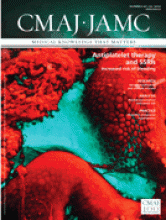SSRIs and antiplatelet therapy

Image courtesy of Philip Wong MD MSc, McGill University Health Centre
People taking selective serotonin reuptake inhibitors (SSRIs) together with antiplatelet therapy following acute myocardial infarction were at increased risk of bleeding. This is the finding of a retrospective analysis of linked data from administrative databases covering 27 058 patients discharged from hospital who were followed for up to nine years. Clinicians must weigh the benefits of SSRI therapy against the associated risk of bleeding when prescribing for their patients with major depression following myocardial infarction, say the authors. See Research, page 1835
The risks of therapy with antidepressants and antiplatelets may outweigh the benefits for some patients, particularly those who experience a hemorrhage. See Commentary, page 1819
Statins in people at low cardiovascular risk
Both low- and high-potency statins helped prevent death and cardiovascular-related morbidity in people at low risk of cardiovascular events (whose 10-year risk of cardiovascular-related death or nonfatal myocardial infarction is less than 20%). Tonelli and colleagues identified 29 trials involving more than 80 000 patients for their systematic review of the effect of statins on all-cause mortality and several cardiovascular outcomes in low-risk people. Although reductions in relative risk were similar to those seen in higher risk patients, the number of people needed to be treated to prevent one adverse outcome was relatively high for any statin, say the authors. See Research, page E1189
Statins’ cost-effectiveness in low-risk groups

Image courtesy of © 2011 Thinkstock
The incremental cost-effectiveness of managing people who are at low cardiovascular risk (10-year risk of cardiovascular-related death or nonfatal myocardial infarction < 20%) was $21 300 per quality-adjusted life-year gained with the use of high-potency statins (v. no statins). This finding comes from a Markov model cost-utility analysis from a Canadian perspective. Although extending preventive statin treatment to lower risk groups appears to be economically attractive, the overall expenditure on statins would be substantial, say the authors. See Research, page E1180
Multiple sclerosis and venous blood flow
Chronic cerebrospinal venous insufficiency (CCSVI) — a term used to describe ultrasound abnormalities in the anatomy and flow of intra- and extracerebral veins — is seen more frequently in people with multiple sclerosis. This is the finding of a systematic review of eight case–control studies. However, poor reporting of the success of blinding and marked heterogeneity among the studies precluded definitive conclusions, say the authors. See Research, page E1203
A theory of a vascular cause for multiple sclerosis has been reinvigorated recently with the description of CCSVI and the associated “liberation procedure.” However, the impact of this new intervention requires further investigation before it can be embraced fully. See Commentary, page 1824
Prescribing trimethoprim–sulfamethoxazole

Image courtesy of © 2011 Thinkstock
Over 40 years of use have provided ample opportunity to identify many adverse effects linked to the use of trimethoprim–sulfamethoxazole. Although this drug is an effective antimicrobial, Ho and Juurlink caution that there are important interactions with commonly used medications and other toxicities, some with fatal outcomes. See Review, page 1851
Alcohol consumption and cancer risk

Image courtesy of © 2011 Thinkstock
Guidelines for sensible drinking do not take the dose–response relationship between alcohol consumption and cancer risk into consideration. According to Latino-Martel and colleagues, the amount of evidence for the link between alcohol consumption and cancer has recently increased. On the whole, alcohol is considered an avoidable risk factor for cancer. Current guidelines for sensible drinking are not adequate for the prevention of cancer, and new guidelines based on scientific evidence are needed. See Analysis, page 1861
Breast mass in a man
A 56-year-old man found a lump in his right breast. Common causes of breast masses in men include gynecomastia, malignancy and benign fibrocystic changes; however, the cause of the breast mass in this man was something quite different. See Practice, page 1875











